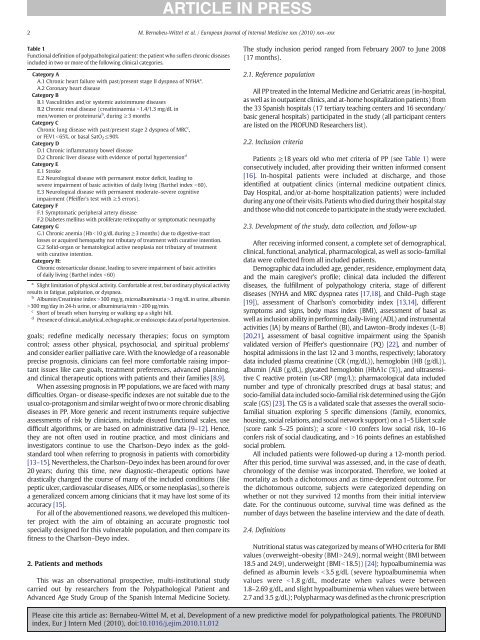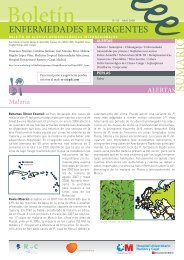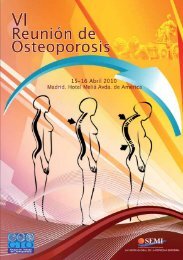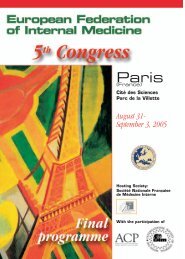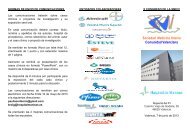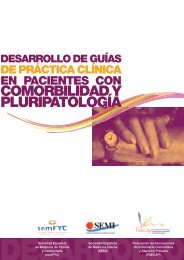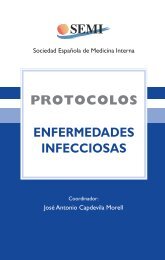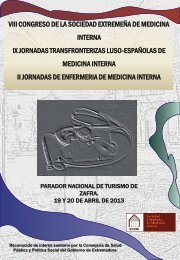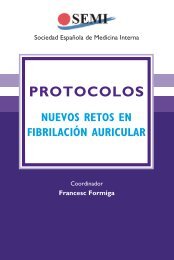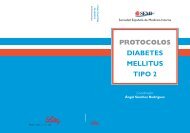Development of a new predictive model for polypathological patients ...
Development of a new predictive model for polypathological patients ...
Development of a new predictive model for polypathological patients ...
- No tags were found...
You also want an ePaper? Increase the reach of your titles
YUMPU automatically turns print PDFs into web optimized ePapers that Google loves.
2 M. Bernabeu-Wittel et al. / European Journal <strong>of</strong> Internal Medicine xxx (2010) xxx–xxxTable 1Functional definition <strong>of</strong> <strong>polypathological</strong> patient: the patient who suffers chronic diseasesincluded in two or more <strong>of</strong> the following clinical categories.Category AA.1 Chronic heart failure with past/present stage II dyspnea <strong>of</strong> NYHA a .A.2 Coronary heart diseaseCategory BB.1 Vasculitides and/or systemic autoimmune diseasesB.2 Chronic renal disease (creatininaemia N1.4/1.3 mg/dL inmen/women or proteinuria b , during ≥3 monthsCategory CChronic lung disease with past/present stage 2 dyspnea <strong>of</strong> MRC c ,or FEV1b65%, or basal SatO 2 ≤90%Category DD.1 Chronic inflammatory bowel diseaseD.2 Chronic liver disease with evidence <strong>of</strong> portal hypertension dCategory EE.1 StrokeE.2 Neurological disease with permanent motor deficit, leading tosevere impairment <strong>of</strong> basic activities <strong>of</strong> daily living (Barthel index b60).E.3 Neurological disease with permanent moderate–severe cognitiveimpairment (Pfeiffer's test with ≥5 errors).Category FF.1 Symptomatic peripheral artery diseaseF.2 Diabetes mellitus with proliferate retinopathy or symptomatic neuropathyCategory GG.1 Chronic anemia (Hbb10 g/dL during ≥3 months) due to digestive-tractlosses or acquired hemopathy not tributary <strong>of</strong> treatment with curative intention.G.2 Solid-organ or hematological active neoplasia not tributary <strong>of</strong> treatmentwith curative intention.Category H:Chronic osteoarticular disease, leading to severe impairment <strong>of</strong> basic activities<strong>of</strong> daily living (Barthel index b60)aSlight limitation <strong>of</strong> physical activity. Com<strong>for</strong>table at rest, but ordinary physical activityresults in fatigue, palpitation, or dyspnea.b Albumin/Creatinine index N300 mg/g, microalbuminuria N3 mg/dL in urine, albuminN300 mg/day in 24-h urine, or albuminuria/min N200 μg/min.c Short <strong>of</strong> breath when hurrying or walking up a slight hill.d Presence <strong>of</strong> clinical, analytical, echographic, or endoscopic data <strong>of</strong> portal hypertension.goals; redefine medically necessary therapies; focus on symptomcontrol; assess other physical, psychosocial, and spiritual problems‘and consider earlier palliative care. With the knowledge <strong>of</strong> a reasonableprecise prognosis, clinicians can feel more com<strong>for</strong>table raising importantissues like care goals, treatment preferences, advanced planning,and clinical therapeutic options with <strong>patients</strong> and their families [8,9].When assessing prognosis in PP populations, we are faced with manydifficulties. Organ- or disease-specific indexes are not suitable due to theusual co-protagonism and similar weight <strong>of</strong> two or more chronic disablingdiseases in PP. More generic and recent instruments require subjectiveassessments <strong>of</strong> risk by clinicians, include disused functional scales, usedifficult algorithms, or are based on administrative data [9–12]. Hence,they are not <strong>of</strong>ten used in routine practice, and most clinicians andinvestigators continue to use the Charlson–Deyo index as the goldstandardtool when referring to prognosis in <strong>patients</strong> with comorbidity[13–15]. Nevertheless, the Charlson–Deyo index has been around <strong>for</strong> over20 years; during this time, <strong>new</strong> diagnostic–therapeutic options havedrastically changed the course <strong>of</strong> many <strong>of</strong> the included conditions (likepeptic ulcer, cardiovascular diseases, AIDS, or some neoplasias), so there isa generalized concern among clinicians that it may have lost some <strong>of</strong> itsaccuracy [15].For all <strong>of</strong> the abovementioned reasons, we developed this multicenterproject with the aim <strong>of</strong> obtaining an accurate prognostic toolspecially designed <strong>for</strong> this vulnerable population, and then compare itsfitness to the Charlson–Deyo index.2. Patients and methodsThis was an observational prospective, multi-institutional studycarried out by researchers from the Polypathological Patient andAdvanced Age Study Group <strong>of</strong> the Spanish Internal Medicine Society.The study inclusion period ranged from February 2007 to June 2008(17 months).2.1. Reference populationAll PP treated in the Internal Medicine and Geriatric areas (in-hospital,as well as in outpatient clinics, and at-home hospitalization <strong>patients</strong>) fromthe 33 Spanish hospitals (17 tertiary teaching centers and 16 secondary/basic general hospitals) participated in the study (all participant centersare listed on the PROFUND Researchers list).2.2. Inclusion criteriaPatients ≥18 years old who met criteria <strong>of</strong> PP (see Table 1) wereconsecutively included, after providing their written in<strong>for</strong>med consent[16]. In-hospital <strong>patients</strong> were included at discharge, and thoseidentified at outpatient clinics (internal medicine outpatient clinics,Day Hospital, and/or at-home hospitalization <strong>patients</strong>) were includedduring any one <strong>of</strong> their visits. Patients who died during their hospital stayand those who did not concede to participate in the study were excluded.2.3. <strong>Development</strong> <strong>of</strong> the study, data collection, and follow-upAfter receiving in<strong>for</strong>med consent, a complete set <strong>of</strong> demographical,clinical, functional, analytical, pharmacological, as well as socio-familialdata were collected from all included <strong>patients</strong>.Demographic data included age, gender, residence, employment data¸and the main caregiver's pr<strong>of</strong>ile; clinical data included the differentdiseases, the fulfillment <strong>of</strong> polypathology criteria, stage <strong>of</strong> differentdiseases (NYHA and MRC dyspnea rates [17,18], and Child–Pugh stage[19]), assessment <strong>of</strong> Charlson's comorbidity index [13,14], differentsymptoms and signs, body mass index (BMI), assessment <strong>of</strong> basal aswell as inclusion ability in per<strong>for</strong>ming daily-living (ADL) and instrumentalactivities (IA) by means <strong>of</strong> Barthel (BI), and Lawton–Brody indexes (L–B)[20,21], assessment <strong>of</strong> basal cognitive impairment using the Spanishvalidated version <strong>of</strong> Pfeiffer's questionnaire (PQ) [22], and number <strong>of</strong>hospital admissions in the last 12 and 3 months, respectively; laboratorydata included plasma creatinine (CR (mg/dL)), hemoglobin (HB (g/dL)),albumin (ALB (g/dL), glycated hemoglobin (HbA1c (%)), and ultrasensitiveC reactive protein (us-CRP (mg/L); pharmacological data includednumber and type <strong>of</strong> chronically prescribed drugs at basal status; andsocio-familial data included socio-familial risk determined using the Gijónscale (GS) [23]. The GS is a validated scale that assesses the overall soci<strong>of</strong>amilialsituation exploring 5 specific dimensions (family, economics,housing, social relations, and social network support) on a 1–5Likertscale(score rank 5–25 points); a score b10 confers low social risk, 10–16confers risk <strong>of</strong> social claudicating, and N16 points defines an establishedsocial problem.All included <strong>patients</strong> were followed-up during a 12-month period.After this period, time survival was assessed, and, in the case <strong>of</strong> death,chronology <strong>of</strong> the demise was incorporated. There<strong>for</strong>e, we looked atmortality as both a dichotomous and as time-dependent outcome. Forthe dichotomous outcome, subjects were categorized depending onwhether or not they survived 12 months from their initial interviewdate. For the continuous outcome, survival time was defined as thenumber <strong>of</strong> days between the baseline interview and the date <strong>of</strong> death.2.4. DefinitionsNutritional status was categorized by means <strong>of</strong> WHO criteria <strong>for</strong> BMIvalues (overweight–obesity (BMIN24.9), normal weight (BMI between18.5 and 24.9), underweight (BMIb18.5)) [24]; hypoalbuminemia wasdefined as albumin levels b3.5 g/dL (severe hypoalbuminemia whenvalues were b1.8 g/dL, moderate when values were between1.8–2.69 g/dL, and slight hypoalbuminemia when values were between2.7 and 3.5 g/dL); Polypharmacy was defined as the chronic prescriptionPlease cite this article as: Bernabeu-Wittel M, et al, <strong>Development</strong> <strong>of</strong> a <strong>new</strong> <strong>predictive</strong> <strong>model</strong> <strong>for</strong> <strong>polypathological</strong> <strong>patients</strong>. The PROFUNDindex, Eur J Intern Med (2010), doi:10.1016/j.ejim.2010.11.012


